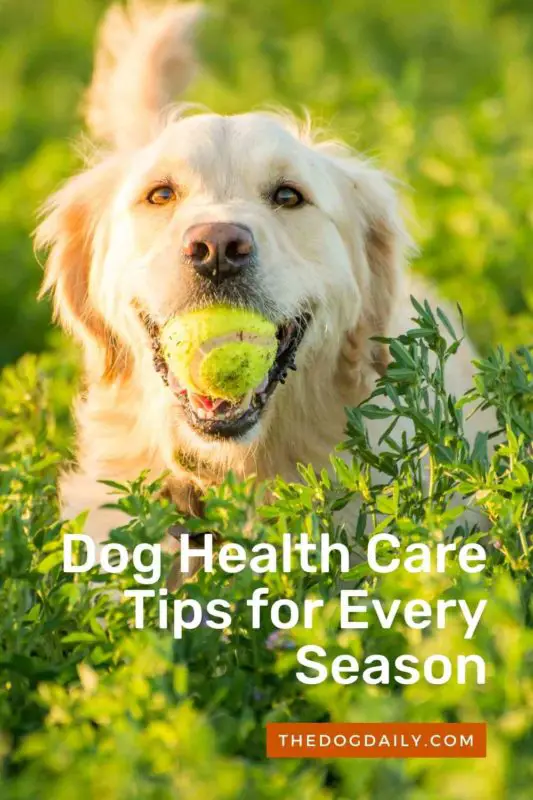What are the Seasonal Health Concerns for Dogs?
Through rain, snow, sleet, or 90-degree temperatures, something else is delivered to our homes as regularly as the mail: seasonal health hazards that affect the family dog.
Depending upon the time of year, your dog is likely to suffer from some medical issues. The winter months bring exposure to the cold weather, dangerous plants — like poinsettias — and potentially hazardous foods, such as chocolate. On the other hand, from late spring through early fall, fleas, ticks, and other parasites attack.
Here’s how you can make sure your mental calendar is on the alert for your dog’s seasonal health issues:
-
Avoid long-term exposure to the elements.
Dogs left in freezing temperatures for too long can develop frostbite in their ears and paws. How much exposure they can take depends on the breed — hairless or small dogs can succumb to cold weather in minutes, while a thick-coat breed may be able to sleep in the snow, Peterson says. You can help your dog in winter by trimming the fur around your dog’s pads so that ice and snow won’t stick and clump. You can also towel off your dog’s feet so that they dry quicker. Also, consider investing in an ointment to keep pads from cracking. For more winter advice see our article ‘Keep Your Dog Warm and Safe this Winter‘.
During summer, your dog should not be left in the car when temperatures rise above about 70 degrees. Be careful when taking your pet for a walk on asphalt or the beach in high temperatures. Touch the surface yourself to make sure it won’t burn the dog’s paws. For more advice on keeping your dog safe during hot summer temperatures, see our article ‘Help Your Dog Beat the Heat of Summer‘.
-
Ready yourself for allergies and pests in the spring and summer
When you start sneezing because plants are blooming, be aware that your canine companion may be an allergy sufferer, too. “Dogs can develop allergies to the same things people can, so seasonal pollens are common causes,” Beaver says. Some clues: your dog may start to scratch, lick or bite its body. Or it may shake its head frequently or rub its snout along the carpet. Treatments include allergy medications and baths with shampoos that contain soothing oatmeal and/or aloe vera. Flea allergies are among the most common in dogs, particularly in summer when fleas are most active. Also active in the summer are ticks, which can cause illnesses, such as Lyme disease, and Rocky Mountain spotted fever. Fortunately, flea and tick medications are available to prevent infestations. Consult your veterinarian for advice.
-
Watch what your dog eats during holidays.
You may need to avoid certain foods during Thanksgiving, Christmas, Hanukah, Kwanzaa, or other seasonal celebrations. Your dog’s diet also should be monitored. “Dogs often get into very fatty foods like gravy, turkey fat, etc., and can develop pancreatitis,” says Dr. Bonnie V. Beaver, BS, DVM, MS, DACVB, who teaches in the Department of Small Animal Clinical Sciences at Texas A&M University. This inflammation of the pancreas, a gland behind the stomach that helps with digestion, can result in vomiting in mild cases or life-threatening. Beaver says you should also be aware that some holiday foods you might cherish may be poisonous to dogs. These questionable foods include chocolate, macadamia nuts, raisins, and grapes. For more advice on feeding your dog during the holiday season, see our article ‘Preventing Holiday Dog Food Disasters‘.
-
Deck the halls — with limitations
When breaking out the icicle lights and plastic Santa, be aware that some holiday decorations are harmful to pets. “People need to look at what their decorations are throughout the house,” says Lisa Peterson, spokesman for the American Kennel Club. “Are they within the dog’s reach?” Dogs will zone in on new decorations. Peterson says poinsettias, mistletoe, holly, and other plants can be poisonous and/or harmful to dogs. But you also need to watch out for the Christmas tree. Don’t let them drink the water, which may contain additives or plant foods. And avoid low-lying decorations — particularly glass — which may look like a chew toy to a curious pup.
-
See your vet for check-ups.
Every pet should have a check-up at least once a year. “As they get older, the frequency
should increase to twice a year and be more intense, such as monitoring blood work,” Beaver recommends. During a check-up, you and your veterinarian can discuss preventative care, such as vaccinations against infectious diseases (such as rabies and distemper) or medications to fight flea infestations and heartworm. Heartworm is a parasitic roundworm spread to dogs through mosquito bites. In the Sun Belt, dogs need to be given medication year-round; time it for the first of the month or put a sticker on your calendar as a reminder. At an annual spring check-up in Northern climates, dogs can be tested for heartworm and started on a seasonal dosage of medication.
Article written by Author: Elizabeth Wasserman

